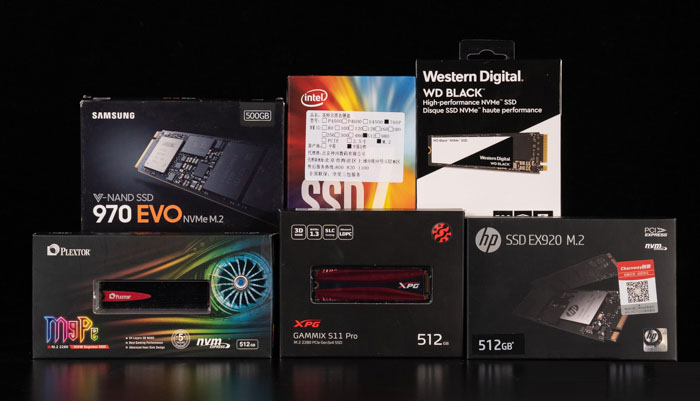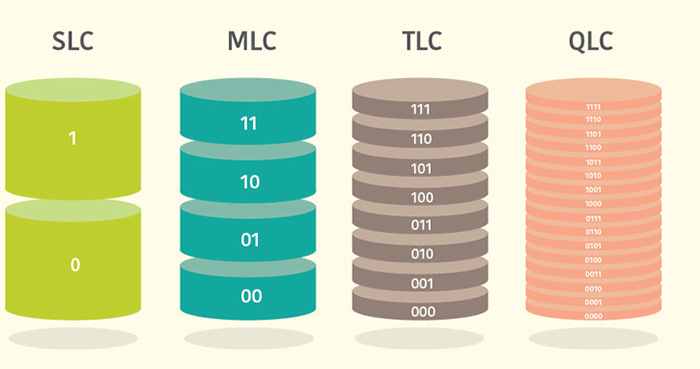Why does speed drop happen in TLC/QLC SSD? (1)
Nowadays, it is 2019. When it comes to install or upgrade the personal computers, solid state drives are known as the first choice, which is deeply rooted in people's hearts for a long time. In addition, when the price of NAND flash memory has been declining over the past year, solid state drive price is also cutting. It is a masterstream for solid state drive with capacity of 1 TB sold at $147. When considering the performance, you can also buy a better M.2 hard disk instead of SATA hard disk. What is more, some miscellaneous solid state drives sold at $0.07 per GB can be chosen to serve as warehouse disks. Looking back at hard disk drives that have not been reduced in price for many years, it is easy to understand why the market of hard disk drives is declining.

However, when hard disk drives are gradually moving away from laptop market, does it represent there are no drawbacks in solid state drives? Of course, it is not true. Under such an environment with price reduction, although solid state drive is popular in our daily life, it still has a disgusting problem, namely, declining performance. In terms of gradually declining performance of solid state drive, experienced users should have experience it, while some people actually do not realize this problem. Today, let us talk about declining performance of solid state drive.
There is no exact definition of declining performance of solid state drive currently. Here we will literally understand it as "performance reduction", and analyze its causes and solutions. If you want to better understand performance reduction of solid state drive, I suggest that you should read two cross-reviews we have done before:
Cross reviews among fourteen 120/128GB solid state drives in 2012. (https://www.expreview.com/19604-all.html)
Cross reviews among sixteen 240/256GB solid state drives in 2014. (https://www.expreview.com/35927-all.html)
Is QLC Flash reliable and stable? (https://www.expreview.com/63677.html)
Change from SLC to MLC, TLC and QLC
Is the upgrading of flash type also causing solid state drive to decline its performance? It is true to think about it carefully. In fact, we can think that it is just the changing flash types that cause solid state drive to decline performance more and more seriously. If we still use SLC flash, it will not exit such problem. However, SLC solid state drive is not always used, because the best flash means the highest cost. Even if manufacturers now have abilities of using SLC flash as the master flash, ordinary consumers can't afford it.

With changing from SLC to MLC, TLC and QLC, every cell can save more and more charge bits, and its capacity is increasing, so the corresponding cost is decreasing. However, it is a pity that the inherent characteristics of NAND flash memory represents the more potential, the more complex to control and the longer to write data, resulting in a significant decline in performance (especially in write performance, read performance is just OK).
The performance of solid state drive integrated with TLC and QLC flash is good. SATA interface can achieve 500 MB/s write speed. Depended on different channels of PCIe 3.0, M.2 interface can reach 1 GB/s, 2 GB/s or even higher. But in fact, this performance is not real, and it is the best performance under ideal conditions.

The figure above is the actual performance of Intel QLC flash 660P hard disk. As the amount of written data increases and the cache space is exhausted, the original performance of QLC will be exposed. When the write speed will be reduced to 100MB/s, solid state drive is no faster than hard disk drive.
Garbage collection GC, TRIM
When it comes to the problem of performance reduction in solid state drive, experienced players may also recall that Plextor claimed its high-performance M-series solid state drive without performance reduction in earlier years. This selling point attracted many SSD users to buy it at that time. Considering that MLC flash was still the master in the market at that time, declining performance in solid state drive was masterly due to the problem of the master control management mechanism.

The problem is specifically caused by garbage collection and TRIM. If you have read our previous popular science articles, you may know that the special feature of NAND flash memory is the way to write files. Before writing files, the blocks of NAND flash needs to be erased one by one. All kinds of write and erase operations leave messy data in solid state drive. Some of them are still useful, while some are invalid. Garbage collection is as follow. First, useful data on a block is copied to another block. Then, the original block is erased. At last, such an empty block is prepared for writing new data. By this way, the performance of solid state drive will be restored.
In addition to garbage collection mechanism, Microsoft has introduced TRIM into Windows 7 and later systems. This is an instruction based on SATA controller. Once a file is deleted or formatted partially, the operating system will send TRIM instructions to solid state drive master to tell it that data somewhere is deleted. Thus, solid state drive knows whether data is valid or invalid, and then it can do empty operation to restore its performance.
Garbage collection and TRIM can also affect performance reduction of solid state drive. But now these operations have become the basic functions of solid state drive, and are supported on the operating system. Therefore, performance reduction caused by garbage collection and TRIM is much less.
Performance reduction of 840 EVO
With the development of SLC, MLC, TLC and QLC, not only the performance of flash memory is declining, but also the reliability is decreasing. In terms of physical layer, TLC and QLC flash memory has more charge potential and more complex control. As time goes on, the activity of electrons will also be lost. When TLC flash memory came into being, Samsung 840 EVO happened to performance reduction thanks to idle for a long time.

Samsung also conducted a survey on this issue, saying, "With the help of flash management software algorithms, solid state drive usually corrects the status of cell over time. Read-retry operation in 840 EVO is too aggressive, resulting in a decline in overall read performance. It is worth noting that this only happens when there is no data change in its internal cell. If data in its cell is subsequently migrated or overwritten, there will be no performance reduction problem”.
Finally, Samsung released a new firmware to solve performance reduction of 840 EVO. Interesting, on this issue, Samsung did not acknowledge that this is caused by TLC flash. In fact, TLC flash had a large number of problems from flash memory to master management in the early stage of development. It was not surprising for TLC flash memory to contribute to performance reduction.
Master control overheat protection
The causes mentioned above about performance reduction are based on flash memory, but master control is also affect performance reduction. For example, it is masterly caused by the overheating protection in solid state drive. There is basically no such problem on SATA hard disk. Most problems masterly happen after a large number of high-performance M.2 hard disk is listed.
